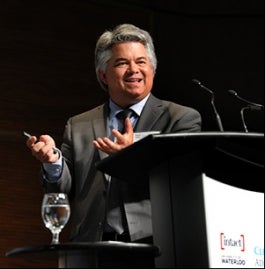
Waterloo research supports national climate change project
From rain gardens to permeable parking lots: Preparing for extreme weather will help Canadians avoid billions of dollars in losses, says Waterloo prof

From rain gardens to permeable parking lots: Preparing for extreme weather will help Canadians avoid billions of dollars in losses, says Waterloo prof
By Staff Marketing and Strategic CommunicationsA Waterloo researcher is working to protect Canadians from catastrophic losses by supporting a new nationwide project to help communities safeguard their homes and businesses during extreme weather.
Climate change means storms like the recent floods in Southern Alberta and Toronto are increasing across Canada, and Blair Feltmate, chair of the Climate Change Adaptation Project (CCAP), says communities need to adapt or risk billions of dollars in damage.
 “Climate change is a reality, and the events of the last year clearly demonstrate the need to weather-harden our communities, our infrastructure and our homes,” says Feltmate, an associate professor in Waterloo’s Faculty of Environment.
“Climate change is a reality, and the events of the last year clearly demonstrate the need to weather-harden our communities, our infrastructure and our homes,” says Feltmate, an associate professor in Waterloo’s Faculty of Environment.
The national project, established in collaboration with Intact Financial Corporation through the CCAP, will be carried out in 20 locations in Alberta, British Columbia, Nova Scotia, Ontario and Quebec.
The projects will showcase how communities can adapt so that extreme weather results in fewer and less substantial losses. It is the intention that the projects will be ultimately replicated in communities across the country.
Examples of projects supported through the CCAP include:
The projects emerged from CCAP’s 2012 report that outlined a roadmap of priorities and recommendations to adapt to climate change. They focus on reducing the impact of torrential precipitation by restoring urban wetlands and water channels. Other initiatives include the construction of rain gardens, bio-swales and permeable parking lots and roads.
In addition, educational campaigns will promote practical measures that homeowners can engage around their homes to help stop or limit the impacts of basement flooding.
 Charles Brindamour, chief executive officer of Intact Financial Corporation, says: “This is a multi-stakeholder endeavour and we are thankful to the governmental agencies, NGOs and consumers that will participate in these projects. Together we will foster adaptation initiatives that will allow Canadians to better adapt to our changing climate.”
Charles Brindamour, chief executive officer of Intact Financial Corporation, says: “This is a multi-stakeholder endeavour and we are thankful to the governmental agencies, NGOs and consumers that will participate in these projects. Together we will foster adaptation initiatives that will allow Canadians to better adapt to our changing climate.”
CCAP, launched in 2010, focused on how Canada can adapt to climate change. The 80 experts who contributed to the project come from diverse backgrounds including academia, law, banking, insurance, NGOs, Aboriginal communities, utilities and more.
“Preparing for climate change is non-negotiable. Extreme weather events will continue to increase in frequency and magnitude,” Feltmate says. “Adaptation is the only means to avoid financial and social costs that will otherwise be borne by all levels of government, industry and consumers.”

Read more
The medal honours outstanding individuals across Canada who have made significant contributions to their communities

Read more
Waterloo welcomes emerging postdoctoral scholars to receive funding from Provost fellowship programs

Read more
Meet the five exceptional graduate students taking the convocation stage as Class of 2024 valedictorians
The University of Waterloo acknowledges that much of our work takes place on the traditional territory of the Neutral, Anishinaabeg, and Haudenosaunee peoples. Our main campus is situated on the Haldimand Tract, the land granted to the Six Nations that includes six miles on each side of the Grand River. Our active work toward reconciliation takes place across our campuses through research, learning, teaching, and community building, and is co-ordinated within the Office of Indigenous Relations.
Select 'Accept all' to agree and continue. You consent to our cookies if you continue to use this website.